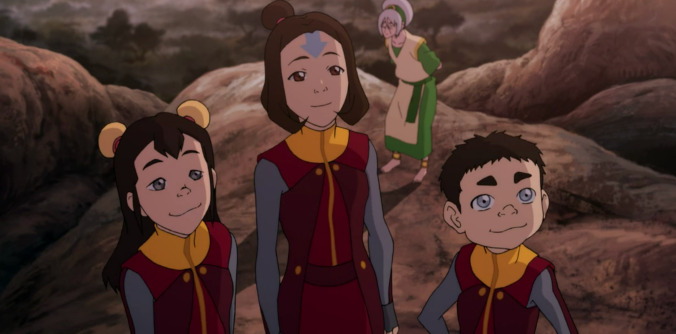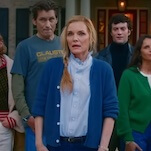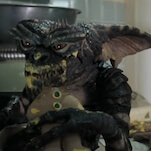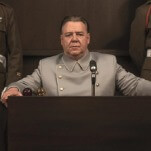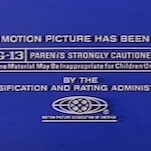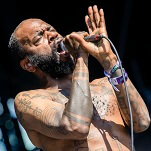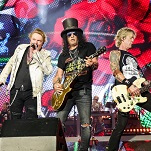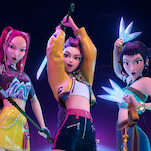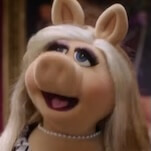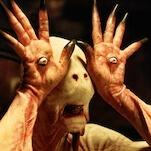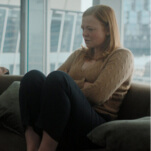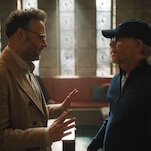When she arrives in Republic City, Korra is exposed to social inequality, the banality of bureaucratic hurdles, and the perverse nature of political power plays for the first time in her life. Even as she learns how to connect with her spiritual self in order to master air-bending, she must also figure out her place as the Avatar in a world where modern technology has greatly replaced spirituality, as well as deal with a growing group of dissidents who argue that the world has moved beyond the need for bending. This conflict forms the backbone of the first season of Legend Of Korra, which premiered on Nickelodeon on April 14, 2012, four years after the end of Avatar. Though the series was originally developed as a standalone 12-episode miniseries, executives initially green-lit a second season of 13 additional episodes and then two additional seasons, for a total of 52 episodes across four seasons (also called “books,” echoing its predecessor). As such, Legend Of Korra doesn’t have an overarching story arc or antagonist that carries through its complete run like Avatar. Each of the four seasons effectively stand alone as a separate story arc, with four separate antagonists.
When the budget was cut once again for season four, series creators Bryan Konietzko and Michael Dante DiMartino had to convert one of the episodes into a “clip show” in order to avoid laying off a significant number of staff. Legend Of Korra also struggled with an inconsistent airing schedule, limited advertising, and episodes prematurely leaked onto the internet. While the first two seasons and the first eight episodes of the third season aired live on Nickelodeon, the remaining episodes premiered exclusively online, starting with the ninth episode of season three through the conclusion of the series.
“Welcome To Republic City” (book one, episode one)
“Welcome to Republic City” is an energetic introduction to the world and characters of Legend Of Korra, quickly establishing the new order—Korra, the confident but reckless new Avatar, sheltered and naive about the way the world works though a prodigious bender, a sleek city with a steampunk-meets-1920s Shanghai/New York aesthetic, and a bureaucratic system that has evolved to function just fine without the Avatar at all. Korra discovers these challenges as soon as she secretly arrives in Republic City, when she tries to assert herself by rescuing a shop from gang violence and ends up getting arrested herself by Republic City police for property damage. “You can’t just waltz in here and dole out vigilante justice like you own the place,” scolds Lin Beifong, chief of Republic City Police and Toph’s daughter, frustrating Korra, who doesn’t understand why she can’t help, considering she is the Avatar. Korra soon discovers that there are many other challenges she must face as well in the outside world, including a growing anti-bender movement among disgruntled non-bender citizens, who believe that benders are oppressive. By the end of the episode, Korra realizes that being the Avatar is a much more complicated endeavor than she ever anticipated within the sheltered walls of the South Pole, but she is willing to learn and grow.
“A Leaf In The Wind” (book one, episode two)
By the second episode, Korra is settled into Air Temple Island with Tenzin and his family, ready to begin her air-bending training. However, because air-bending is the most spiritual of the elements and Korra is not at all tapped into her spiritual self, she struggles to connect. She repeatedly fails a basic air-bending exercise that requires her to “dance like a leaf in the wind” rather than forcing her way through. Tenzin, who is tightly wound himself, also struggles to adapt to Korra’s headstrong nature and teenage rebelliousness, especially over pro-bending, a popular competitive sport that Korra loves but which Tenzin considers to be a mockery of the art of bending. Though Tenzin forbids her to watch or listen to any pro-bending matches because “being the Avatar isn’t about fighting” and he doesn’t want her to get distracted from her air-bending training, Korra ignores him, sneaking away to watch a match in person. She even spontaneously joins a team herself: the Fire Ferrets, who need a waterbender to sub in when their team member suddenly quits, infuriating Tenzin when he discovers she has explicitly gone against his wishes. But to both Tenzin and Korra’s surprise, pro-bending might be just what she needs to finally connect and apply his lessons.
“The Revelation” (book one, episode three)
“The Revelation” is where the plot of Legend Of Korra truly begins to ramp up. When the Fire Ferret brothers Mako and Bolin discover that they need to pay 30,000 yuan in order to compete in the pro-bending tournament they have qualified for, they must quickly find a way to get the money. Korra has never had to worry about money because she’s always had people to take care of her; she’s unaware that that is in and of itself a privilege that Mako and Bolin do not have as orphans. Bolin tries to earn cash on the street while Mako gets a job working long hours at the city’s electrical plant. When Mako returns home and finds Bolin missing, he at first assumes his brother might be visiting Korra on Air Temple Island, as he knows that Bolin has a crush on her. Eventually, Korra and Mako team up to search for Bolin in the city, and end up finding more than they bargained for when they discover he has been captured by Amon and the Equalists. “The Revelation” is the first episode in the series to truly take advantage of the urban steampunk setting of Republic City at night, with a compelling combination of stunning cinematography and fast-paced fight choreography.
“Beginnings, Part 1” (book two, episode seven)
The first of two episodes detailing the origins of the Avatar, “Beginnings, Part 1” takes an risk that pays off by diverging completely from the overarching narrative arc to take a step back and introduce Korra—and the audience—to the genesis of the era of the Avatar. After being infected with dark energy that will destroy her Avatar spirit unless she is cleansed, Korra is lowered by fire sages into a healing water pit. There, she meets the spirit of Wan, the first Avatar, who tells her that he will help her find Raava, the spirit of light, by sharing the story of how he became the first Avatar. From here, the animation in “Beginnings, Part 1” transforms into a unique and beautiful style reminiscent of traditional Chinese illustration as the episode follows the beginning of Wan’s journey from scrappy street urchin to Avatar. This illustrative style also gives Wan’s tale an ancient, almost mythical quality that acts as a stark contrast to both the modern setting of Legend Of Korra and the naturalistic setting of Avatar. With the pacing of a fable, the first part of Wan’s tale carries shades of both the myths of Prometheus and Pandora’s Box. We watch as he gains the power of fire-bending through trickery, is banned from his city into the Spirit Wilds, and earns the respect of the spirits who live there through his kindness to a captured cat-deer (who becomes the first Avatar animal guide). Most importantly, Wan inadvertently splits Raava, the spirit of light, from Vaatu, the spirit of darkness, releasing darkness and chaos into the world for the first time in 10,000 years.
“Beginnings, Part 2” (book two, episode eight)
Both Legend Of Korra and Avatar share a common refrain in that the key role of the Avatar is to bring balance to the world, whether that means bringing an end to a hundred year war or figuring out how to integrate spirituality into an increasingly modern world. As “Beginnings, Part 2” shows, bringing balance is the ceaseless work of lifetimes, borne of the consequences of Wan’s reckless act of separating Raava and Vaatu without fully understanding its repercussions. After the separation, Raava reluctantly agrees to help Wan master the power of the other three elements so they can work together to have a chance at winning against Vaatu during Harmonic Convergence. Unfortunately, they are unable to stop Vaatu from corrupting both humans and peaceful spirits in the mortal world—including the old friends he left behind when he was banished from his city and his spirit friends from the Spirit Wilds. Though Wan fails to save his friends, when Harmonic Convergence finally comes, Raava and Wan are finally able to bond together permanently, defeat Vaatu, and seal the spirit portals so that he can never escape again. However, because darkness has irrevocably entered the mortal world, although Wan tries his best, by the end of his life, it still remains unbalanced. But in his final moments, Raava comforts Wan and tells him not to worry, for she will be with him forever as they work together to bring balance to the world for all his future lifetimes.
“The Metal Clan” (book three, episode five)
Although Lin Beifong is present from the very first episode of the series and plays a key role in the narrative, until the third season, her own backstory mostly remains a mystery, the exception being her volatile romantic history with Tenzin. In “The Metal Clan,” the first of two episodes that focus on Lin and her psyche, these details finally start to reveal themselves. Fissures in her fierce and private exterior are exposed when Korra and the team learn of another new air-bender in the spectacular metal city of Zaofu. In short order, we learn that not only does Lin have a younger half-sister—Suyin Beifong, the founder of Zaofu—but she’s has been estranged from her for 30 years, has refused multiple efforts at reconciliation, and the new air-bender is none other than her own niece, Opal, who she has never even met. When Korra asks Suyin what happened to cause such a substantial rift, she explains that when they were young, Lin was a straight shooter who followed their mother’s footsteps as a cop while she was a rebel who left home at 16 to make her own way in the world. Although Suyin has grown into an extremely accomplished woman greatly changed from the rebellious teenager she once was, she has given up hope that her older sister will ever be a part of her life. After her conversation with Suyin, Korra tries to help bridge the gap by encouraging Opal to approach Lin directly. Unfortunately, Lin rebuffs her niece’s efforts and tells Korra to focus on fixing the world instead of her family.
“Old Wounds” (book three, episode six)
“Old Wounds” picks right up where “The Metal Clan” leaves off, with some new wounds created after Lin’s caustic rebuke of Korra and her cruel rejection of Opal. Exposed and vulnerable in a way she never wanted to be, Lin becomes increasingly stressed and disheveled as she continues refusing to face the issues that are causing her distress. At the suggestion of Aiwei, Suyin’s trusted advisor, Lin finally visits an acupuncturist who tells her she has many unresolved issues from the past that are preventing her from moving forward. Though she scoffs at this, as soon as the acupuncturist places a needle onto a pressure point on her forehead, Lin flashes back to the most traumatic repressed memories of her past: the day she got the permanent scars on her face. They are revealed to be from none other than Suyin herself, who wounded her older sister while trying to help criminals escape and the real reason she left Republic City at 16 in disgrace, to prevent the inevitable scandal of being the the criminal daughter of the city police chief. After the session ends, when Lin still doesn’t feel any better, she realizes she needs to deal with her old wounds in her own way and approaches Suyin in the courtyard for a long overdue confrontation. Korra wonders whether she should stop them, but Bolin tells her that for siblings, “Fighting is part of the healing process,” so she stands back and lets the two sisters duke it out.
“The Stakeout” (book three, episode nine)
Because there are no romantic relationships complicating the rapport between Korra and her friends in the third season, and no adults present in the episode, “The Stakeout” presents a rare opportunity to highlight the best aspects of their dynamic as a true team. With the pacing of a detective film, the first half of the episode follows the four friends as they leave Zaofu in pursuit of Aiwei, Suyin’s trusted advisor turned betrayer, revealed to be in cahoots with the Red Lotus. When they discover he is staying in a nearby hotel, the friends stake out in the room across from Aiwei and wait for him to make a move. Several hours later, Korra decides she’s spent enough time waiting and rushes over to Aiwei’s room and breaks down the door, only to discover him in a meditative state— indicating that the secret meeting place is the spirit world. Mystery solved, the pace quickly switches from detective film to action-adventure; while Korra meditates into the spirit world to find Zaheer and Aiwei, the rest of the team stays behind to watch over her body. Korra doesn’t have to travel far to find Zaheer, who seems surprisingly open to answering all her questions about the history of the Red Lotus and their motivations. Unfortunately, unbeknownst to Korra, Zaheer has figured out where her physical body is located, and has sent other members of the Red Lotus to capture her as he keeps her occupied in the spirit world.
“Korra Alone” (book four, episode two)
“Korra Alone” is a stark, heart-wrenching portrayal of post-traumatic stress disorder. The episode follows Korra closely over the course of three years as she recovers from her attack and learns to cope with the inner demons that haunt her as a result of her trauma. No longer is she the confident, fearless young woman who declared she could take on the world; she is broken both mentally and physically. Six months after the attack, she collapses on the floor of Katara’s healing hut, frustrated that she still can’t take more than a few steps without falling down and trying to make sense of why the attack happened to her. When Katara encourages her to find meaning in her suffering, just as Aang did when he discovered the genocide of his people, Korra takes it to heart and starts to make progress with physical therapy. Unfortunately, her depression still remains unresolved, and she continues to isolate herself from everyone, leaving all her friends’ letters unanswered (with the exception of Asami). After three years, Korra finally decides to return to Republic City for a change of pace, but just as she arrives, her inner trauma manifests as an unnerving physical apparition of herself bound in chains, with poison in her veins, which frightens her into turning right back around. Instead of going back home to the South Pole, Korra cuts her hair and quietly disappears into the Earth Kingdom in order to escape her malevolent spirit self, but she soon learns she cannot outrun it until she learns how to overcome her inner pain.
“The Calling” (book four, episode four)
Though The Legend Of Korra has its share of humor, overall, it is a far more serious series than its predecessor, especially in the fourth season, where the first few episodes focus on the immediate aftermath of the attack on Korra and her long journey to recovery. But the final installment in Korra’s recovery arc, “The Calling,” has two alternating storylines that strike the perfect balance between levity and compassion. The leading storyline follows Tenzin’s children Jinora, Ikki, and Meelo on their first solo mission: They set out in search of Korra after they learn she has gone missing. Even though the kids aren’t much younger than Aang and Katara were during their adventures, it is a little jarring to see them go off on their own. But it is their youth that makes the air-bender siblings so amusing to watch—their scenes together are an extremely entertaining combination of irritation, pettiness, and teasing as the trio learns to work together and build trust in each other’s instincts and strengths. Meanwhile, Korra, who is still with Toph in the swamp, is forced to confront her fears once and for all. Working through these heady challenges, Korra succeeds and finally reconnects with herself and the people who love her after three long years.
